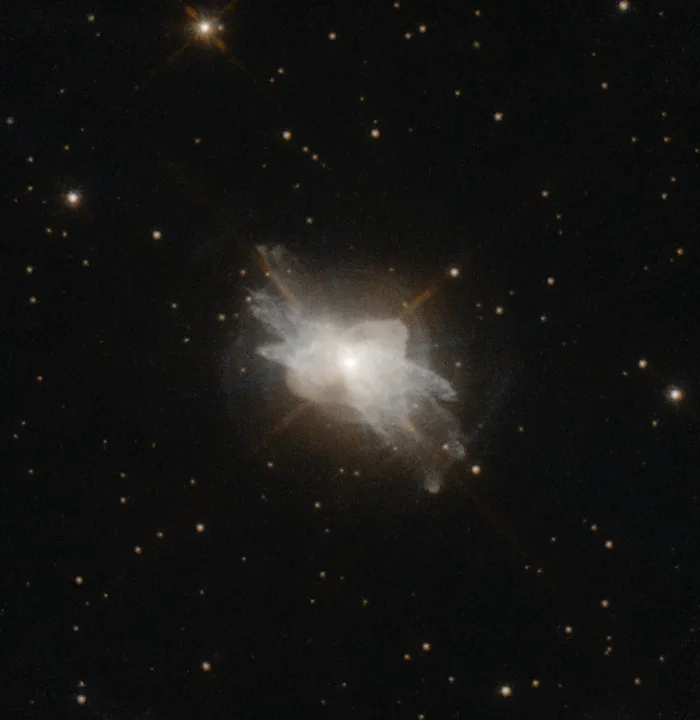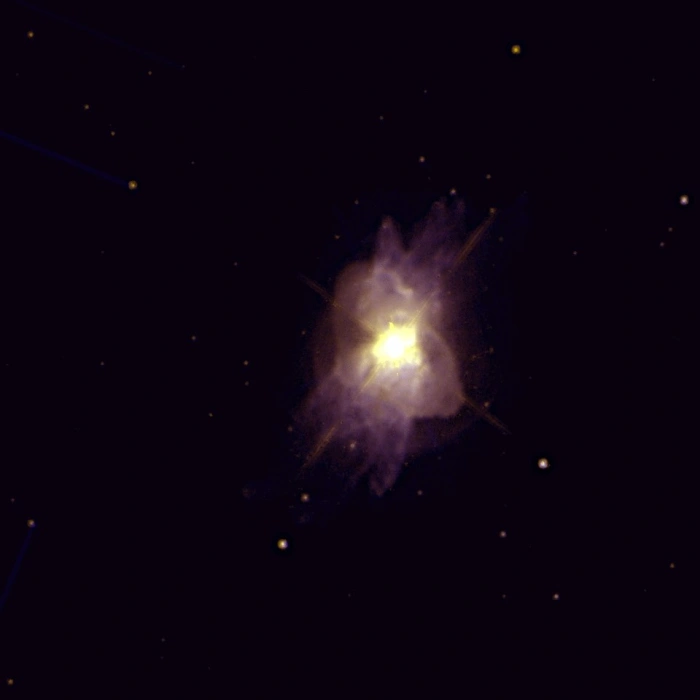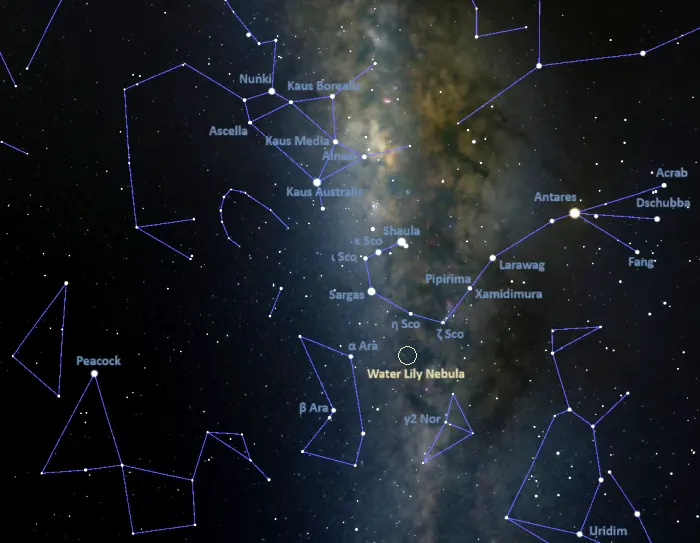The Water Lily Nebula (IRAS 16594-4656) is a bipolar protoplanetary nebula located in the southern constellation of Ara (the Altar). It is one of the pre-planetary nebulae known to contain polycyclic aromatic hydrocarbons (PAHs), organic compounds believed to be starting materials vital for the formation of the earliest forms of life.
IRAS 16594-4656 was named the Water Lily Nebula because it consists of multiple pairs of symmetric structures located at different position angles. These structures give the nebula the appearance of a giant water lily in the sky.
Protoplanetary nebulae are a brief phase in the evolution of Sun-like stars between the asymptotic giant branch (AGB) phase and the planetary nebula phase. As these stars reach the late asymptotic giant branch (AGB) stage of their evolutionary cycle, they experience high mass loss. Their hydrogen envelopes are reduced and their effective temperature starts to rise.

The Water Lily Nebula, image credit: Judy Schmidt (CC BY 2.0)
In the pre-planetary nebula phase, the central stars are still too cool to ionize the shell of expelled material and make it produce its own light. Instead, pre-planetary nebulae reflect the light of the central stars until their progenitors become hot enough to ionize the expanding circumstellar shell. Once the stars reach a temperature of around 30,000 kelvin, they begin to produce enough ultraviolet radiation to ionize the ejected gases, and the slow-moving shells of material evolve from reflection nebulae (protoplanetary nebulae) to emission nebulae (planetary nebulae).
Observations of the Water Lily Nebula have led astronomers to conclude that the central star’s dust envelope has detached from its photosphere and that the large-scale mass loss in the AGB stage has ended. The nebula is not yet a photoionized region, which suggests that it is still evolving toward the planetary nebula phase.
Facts
The Water Lily Nebula was first reported as one of 455 H-alpha emission stars in the Milky Way by C. B. Stephenson and N. Sanduleak at Water and Swasey Observatory in Ohio in 1977.
The object was identified as a protoplanetary nebula based on its IRAS colours by Kevin M. Volk and Sun Kwok of the University of Calgary in 1989.
Bruce J. Hrivnak of the Valparaiso University and Sun Kwok of the University of Calgary are usually credited for the discovery of the Water Lily Nebula. In 1999, the astronomers found optical counterparts for the cool IRAS sources IRAS 16594-4656 in Ara and IRAS 17245-3951 in Scorpius and reported that the central stars are highly reddened and have colour temperatures of 3,000 – 4,000 K.
The reddening indicates that the stars are still obscured by their dust envelopes, which is characteristic of evolved AGB stars. The astronomers named the nebulae the Water Lily Nebula (IRAS 16594-4656) and the Walnut Nebula (IRAS 17245-3951). They are also credited for naming the Silkworm Nebula (IRAS 17441-2411) in the constellation Sagittarius and the Cotton Candy Nebula (IRAS 17150-3224) in Scorpius.
The astronomers derived a distance of 2.6 kiloparsecs (8,480 light-years) for the Water Lily Nebula. They also found that the nebula has an emission feature previously detected in several carbon-rich pre-planetary nebulae, as well as a polycyclic aromatic hydrocarbon (PAH) feature.
Imaging with the Wide Field and Planetary Camera 2 (WFPC2) aboard the Hubble Space Telescope (HST) confirmed that the object is indeed a bipolar nebula seen at an intermediate orientation. The orientation is deduced from the fact that the nebula has a less obvious bipolar structure and that the central star is visible.

The Water Lily Nebula in the constellation of Ara is one of the proto-planetary nebulae where complex organic molecules with aliphatic and aromatic structures are found. This picture was taken with the Hubble Space Telescope Wide Field Planetary Camera on June 28, 1999. Photo credit: Sun Kwok, Bruce Hrivnak, and Kate Su (PD)
In 1998, observations with the Infrared Space Observatory confirmed that the Water Lily Nebula is a member of the rare class of carbon-rich pre-planetary nebulae. A team of astronomers led by Pedro García-Lario of the ISO Science Operations Centre in Madrid, Spain, confirmed the presence of PAHs and suggested that the nebula’s outer envelope changed to carbon-rich chemistry only recently.
In 2002, Griet C. Van de Steene and Peter A. M. van Hoof analysed the near-infrared emission spectrum of the Water Lily Nebula and found strong H2 emission lines. They reported a total extinction of around 7.5 magnitudes for the central star. The star has an apparent magnitude of 14.6.
The astronomers derived a distance of 2.2 kiloparsecs (7,175 light-years) for the nebula based on a luminosity of 104 solar luminosities. They proposed that the strong H2 emission in the nebula is collisionally excited by molecular shocks. They found the central star to be of spectral type B7.
Infrared imaging of the nebula with the Thermal-Region Camera Spectrograph (T-ReCS) on the Gemini South telescope in 2004 revealed a bright equatorial torus and a pair of bipolar lobes. Astronomers believe that the torus appears nearly edge-on. The infrared lobes correspond to the brightest lobes captured in optical images taken by the Hubble Space Telescope, but unlike the optical lobes, they do not show a point-symmetric structure.
Location
The Water Lily Nebula lies in the southern constellation of Ara. It appears south of the midpoint of the imaginary line connecting Zeta Scorpii in Scorpius and Alpha Arae in Ara. It lies along the line connecting Zeta Scorpii and Beta Arae.
At declination -47°, the nebula never rises for observers north of the latitude 43° N.

Water Lily Nebula location, image: Stellarium
Water Lily Nebula – IRAS 16594-4656
| Constellation | Ara |
| Object type | Protoplanetary nebula |
| Right ascension | 17h 03m 10.0705512504s |
| Declination | −47° 00′ 27.731886516″ |
| Apparent magnitude (central star) | 14.6 |
| Apparent size | 5 – 11 arcseconds |
| Distance | 8,480 light-years (2,600 parsecs) or 7,175 light-years (2,200 parsecs) |
| Names and designations | Water Lily Nebula, PN G340.3-03.2, PK 340-03 1, TIC 123620304, IRAS 16594-4656, 2MASS J17031007-4700277, SS 293, GLMP 507, GSC2 S230023014967, MSX6C G340.3924-03.2894, WISE J170310.06-470027.7, Gaia DR2 5963059480546004608, Gaia DR3 5963059480546004608 |